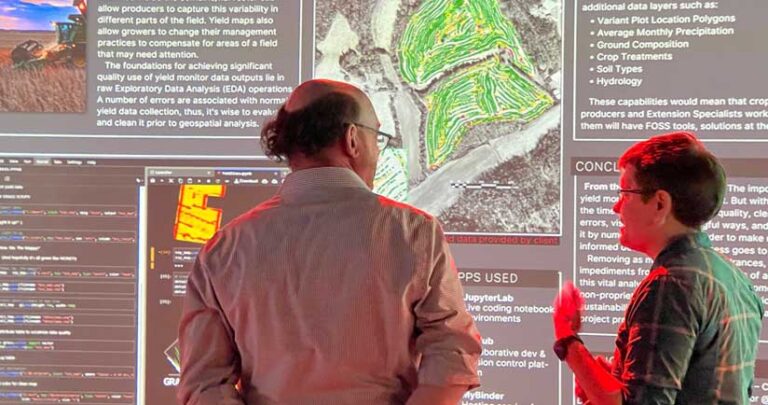At North Carolina State University’s (NCSU) Center for Geospatial Analytics, graduate students benefit from an innovative curriculum that integrates geospatial theory, hands-on applications, and client-based instruction. Students completing the NCSU’s Master of Geospatial Information Science and Technology (MGIST) program capstone project work with community partners to build custom solutions using modern GIS technology and geospatial analysis.

While the capstone project is designed to be challenging, Eric Money, associate director of educational innovation at North Carolina State University, finds that students ultimately regard it as rewarding.
Money is also an associate teaching professor and instructs the MGIST capstone course. “The capstone project is set up so that the partner organization—or community partner—is the client, and the student is the expert. Students build a relationship and develop a fully functional solution in the span of about 15 to 16 weeks. We call it experiential learning.”
Students are paired with government, industry, academic, or nonprofit organizations across the country. Although some organizations have experience with GIS, others might be testing a geospatial solution for the first time. Money tries to frame the experience as a pilot project for the partners.
“Perhaps you don’t have the staff at your current organization to test out some new technologies or use the data you have lying around,” he said. “That’s where our master’s students come in. And for the most part, our students have been successful at creating practical products that the partners really want to use even after the project is over.” Nearly 200 organizations have been partnered with MGIST students since the program began over 12 years ago.
Final projects vary widely in both scope and application—a testament to the broad utility of modern GIS. Collaborative projects between students and partner organizations have improved railways, tracked city infrastructure, and georeferenced imagery.
As an intern for the North Carolina Department of Transportation (NCDOT), MGIST student Summer Faircloth helped the Rail Division analyze its investments. “Railroads are commonly referred to as the ‘first and last mile’” for transporting goods, Faircloth explained. “They play a critical role in North Carolina’s economy by ensuring the efficient and safe transport of freight.” Through Faircloth’s efforts, Rail Division will be able to determine the impact of NCDOT grants.
MGIST student David Kist helped the City of Oxford, North Carolina, prioritize the maintenance of its utility infrastructure. He developed a web mapping application that calculates and spatially displays the risk of water and sewer pipe failure that helps city staff members more efficiently manage inspections, repairs, and replacements.
Working with Durham County Stormwater and Erosion Division, MGIST student Andrew Freeland helped more effectively collect stormwater utility fees by using remotely sensed imagery to more accurately calculate fees charged to property owners. Fees are based on the square footage of impervious surface.
Money determines the pairing of students and community partners. He has found that matching students based on their initial enthusiasm about a project leads to the best engagement and outcomes. One project he oversaw involved a former teacher who had entered the MGIST program. She was ultimately paired with a local school district in Wake County, North Carolina.
“The client was looking at doing some indoor mapping of schools related to safety measures,” Money said. “She was able to explore new technologies, such as ArcGIS Indoors, and help the district build a dashboard and analyze data related to its schools. This was something really novel at the time.
“For many students, this is the first time they’ve really had to work through a project from beginning to end. You start with something on a piece of paper, and you end up with a working product,” he said. During their final semester, students collaborate with organizations to build practical, custom solutions using modern GIS technology and geospatial analysis.
Clear Expectations and Direction Lead to Collaborative Success
It’s crucial to set clear expectations from the onset of every MGIST capstone project, for both community partners and students. Money wants to ensure that partners and students work together as collaborators, not employer and intern. He also reiterates that projects are subject to certain requirements and guidelines.
Money is responsible for enlisting potential community partners. Prior to each semester, he sends out an open call for proposals. NCSU Center for Geospatial Analytics faculty have cultivated a list of organizations and GIS professionals, whom Money reaches out to.
“The way we frame these projects for our community partners is, ‘What tools can our students develop for your organization to help you better analyze your spatial data?’ That’s the overarching goal of the capstone project,” said Money.
“Since it’s the capstone [project], the idea is to bring together all of the knowledge we’ve tried to teach our students across the master’s program”, said Money.
Students can help steer the direction of projects to develop a GIS solution that demonstrates the required skills. Organizations interested in applying complete a capstone project partner form. This gives Money important background information about the organizations’ possible project ideas and expectations, as well as the data that will be available to the students.
Using these initial forms, Money compiles a request-for-proposal packet that his students review during the first week of class. Each student then writes three short preproposals for the projects that have captured their interest. Money then assigns students to their final community partners—typically, a single student to a single organization.
Once paired with a partner organization, students must meet with the client to assess the project. This entails defining its scope, learning more about data access, and understanding the expected final deliverable materials. Students may use a variety of tools while developing their solution, including ArcGIS Online, ArcGIS Pro, and Esri apps such as ArcGIS Experience Builder, as well as links to open-source solutions like PostgreSQL.
“One of the big components that’s required for the capstone project is [that] each student has to set up a stand-alone GIS server,” said Money. “They’re implementing the IT side of GIS, using ArcGIS Enterprise and associated applications.”
Students also submit a professional proposal about the project to Money and his teaching assistant for feedback to guide them on what is achievable during the project time frame. After these initial tasks, students are expected to complete milestone assignments. These include a formal data management plan and a modeling and analytical summary of their technical approach prior to submitting their final documents. “We try to provide students some formal deadlines throughout the semester to keep them as on track as possible, given that these are real-world projects,” said Money.
Meeting a Growing Demand for Higher GIS Education
Over the past few decades, the number of students pursuing advanced degrees in geographic information science has soared. When Money began working at the university in 2014, the Center for Geospatial Analytics had recently added the MGIST program. “NCSU faculty had seen quick growth in the GIS certificate program,” he said. “There was a lot of interest from current working professionals and students to get a better education credential related to GIS and geospatial technologies.” From its onset, the MGIST program was designed as a fully online program to help attract new learners and accommodate nontraditional students.
Money notes that many students who receive a GIS certificate end up entering the master’s program. Credits earned for the certificate can be applied toward an MGIST. Today, there are about 200 students active across the two programs every year.
Initially, the MGIST program primarily attracted working professionals already proficient in GIS and eager to advance their skill set. The composition of geospatial technology classes has shifted over the years. More GIS courses have been added to the undergraduate curriculum and students are being exposed to geospatial science earlier in their academic journeys.
“Now, we have students that are coming straight from their undergrad studies to get their master’s degree,” said Money. “Students are seeing GIS as a viable pathway for a career.”
Graduate students at NCSU who complete the MGIST program receive the Professional Science Master’s (PSM) designation. PSM programs are designed to hone the skills of science professionals via real-world experiences and prepare them for evolving workplace demands. Students complete the semester-long capstone project instead of doing a research thesis.
In addition, the master’s program requires students to incorporate their capstone work into a professional digital portfolio. Documenting the development of their GIS solution and their collaborative efforts with community partners gives students an advantage with employers. “For students who don’t have a lot of existing work experience, this gives them something they can put on their résumé that is real-world demonstration of their skill sets,” Money said.
At the conclusion of the course, students must create a detailed user guide and operations manual to ensure that the solution can be supported even after the student moves on. Students also submit a final resource-oriented report that summarizes the project. The experiential learning, provided by the capstone project, gives students valuable insight that can’t always be surfaced in the classroom.
“For many students, this is the first time they’ve really had to work through a project from beginning to end,” he said. “You start with something on a piece of paper, and you end up with a working product,” said Money.

